Physical Address
304 North Cardinal St.
Dorchester Center, MA 02124
Physical Address
304 North Cardinal St.
Dorchester Center, MA 02124
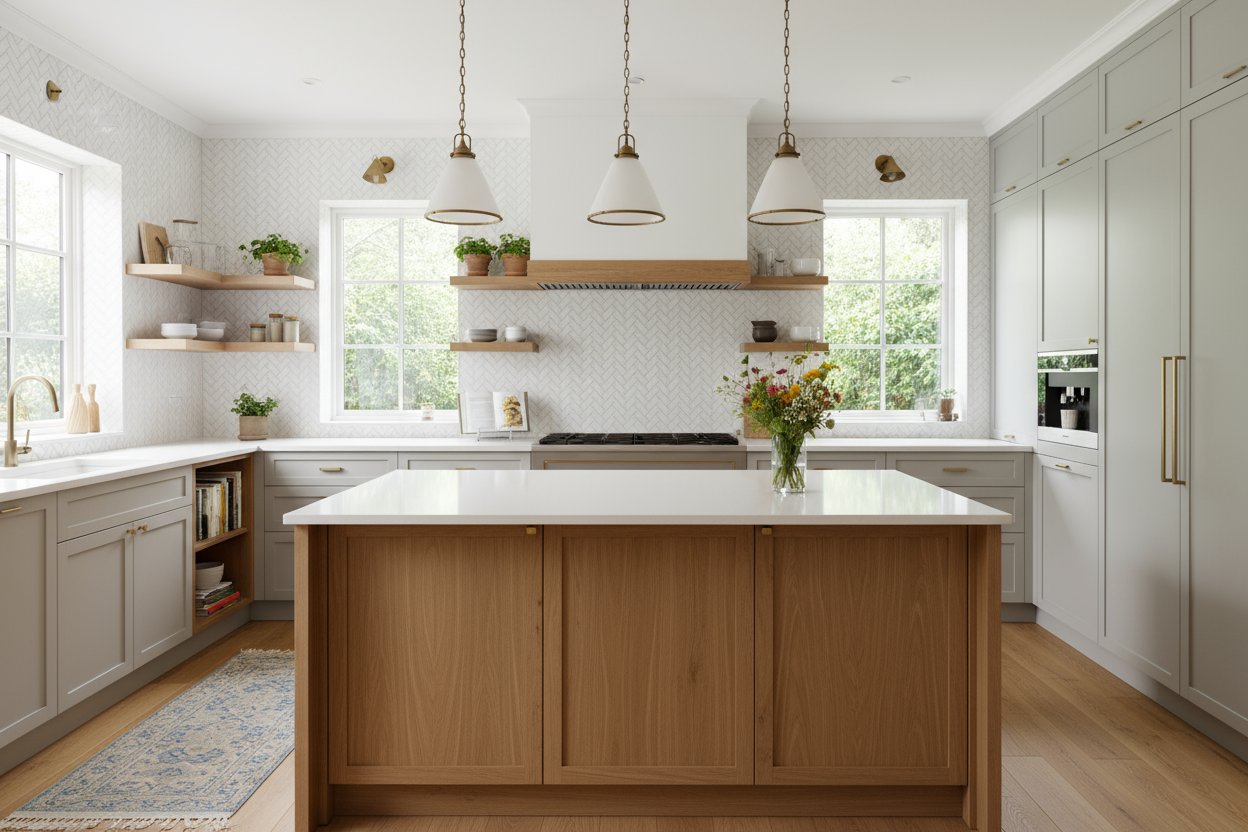
Transform your space with these 20 modern kitchen design ideas. Expert James Hartford shares how to integrate smart tech for a beautiful, future-ready home.
Look, the most successful home designers I know spend way more than half their time not on finishes or colors, but on planning the hidden infrastructure. After years of designing and integrating smart home systems, I’ve realized there’s a framework they all use. It isn’t about just picking out cool gadgets—it’s about building a systematic, future-ready foundation so your kitchen works for you, not against you.
These 20 concepts are that framework. We’ll build from the accessible fundamentals to some seriously advanced applications that will teach you to think about your kitchen not just as a room for cooking, but as the intelligent command center of your home. Let’s dive in.
Before we get to the really slick tech, we have to nail the foundation. These aren’t just aesthetic choices; they are strategic decisions that create the canvas for a truly intelligent and intuitive kitchen. Get these right, and everything else falls into place.
The shift to open-concept isn’t just about making your space feel bigger; it’s about transforming the kitchen into the social and operational hub of your home. By removing walls, you’re not just inviting more light in—you’re creating a fluid environment where you can cook, entertain, and connect with your family without being cut off from the action.
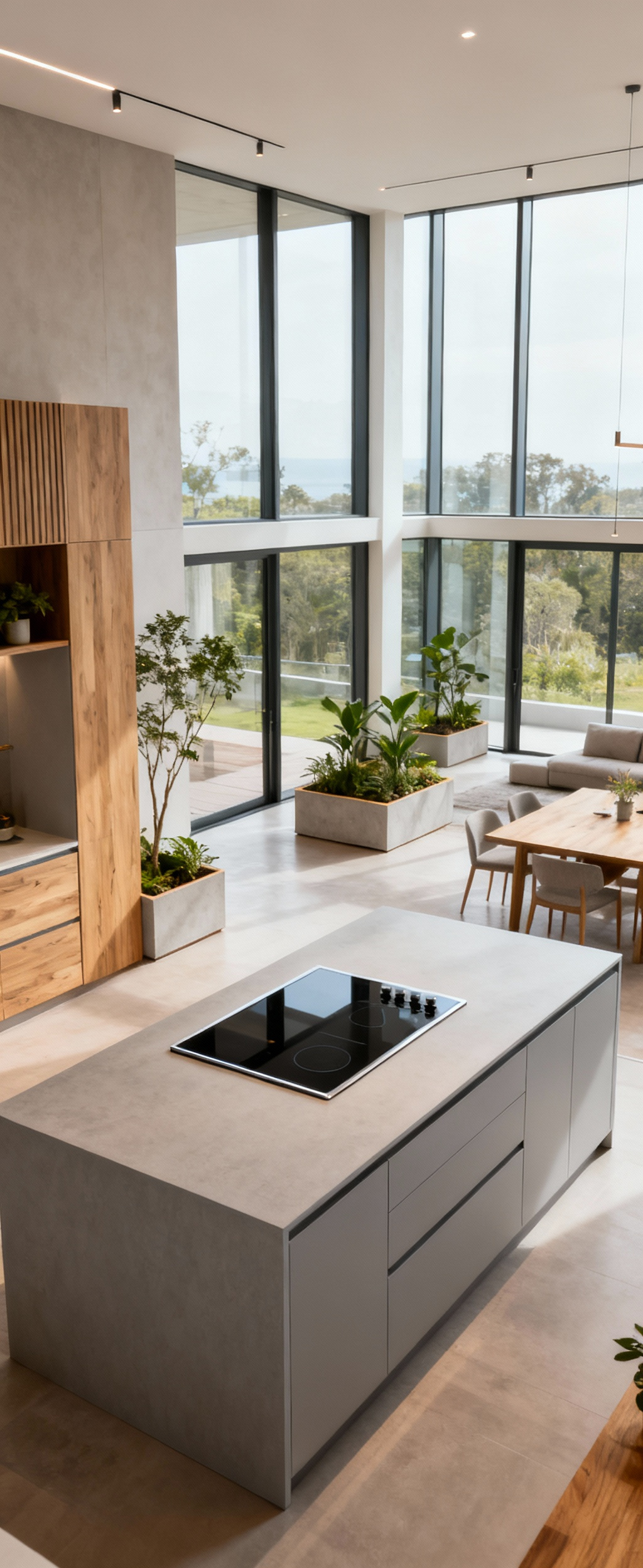
Here’s what’s interesting: this layout is also the perfect foundation for a smart home. It allows voice commands to travel easily, centralized control screens to be seen from the living area, and smart lighting scenes to flow seamlessly across different zones. What I tell my clients is to think less about separate rooms and more about creating smart, defined zones—for cooking, dining, and relaxing—using furniture and lighting, not walls.
Streamlined, handleless cabinets are a non-negotiable in modern design. Why? Because they create a clean, uninterrupted visual plane that feels intentional and uncluttered. It’s the first step toward what I call the “invisible tech” aesthetic. Mechanisms like push-to-open doors or integrated channels maintain that minimalist look, making the cabinetry feel more like part of the architecture.

But it’s more than just looks. A handleless design simplifies cleaning and creates a safer environment with fewer things to snag on. And on a deeper level, it sets the stage for a kitchen where things happen effortlessly. I’ve seen this play out when we install motorized cabinets that open with a light touch or a voice command—it all starts with the clean, hardware-free foundation.
A monochromatic or neutral color palette—think crisp whites, deep charcoals, and warm greys—does more than just look sophisticated. It creates a calm, serene backdrop that allows technology and key design elements to truly stand out. It makes a kitchen feel timeless, so you aren’t stuck with a trendy color that feels dated in five years.
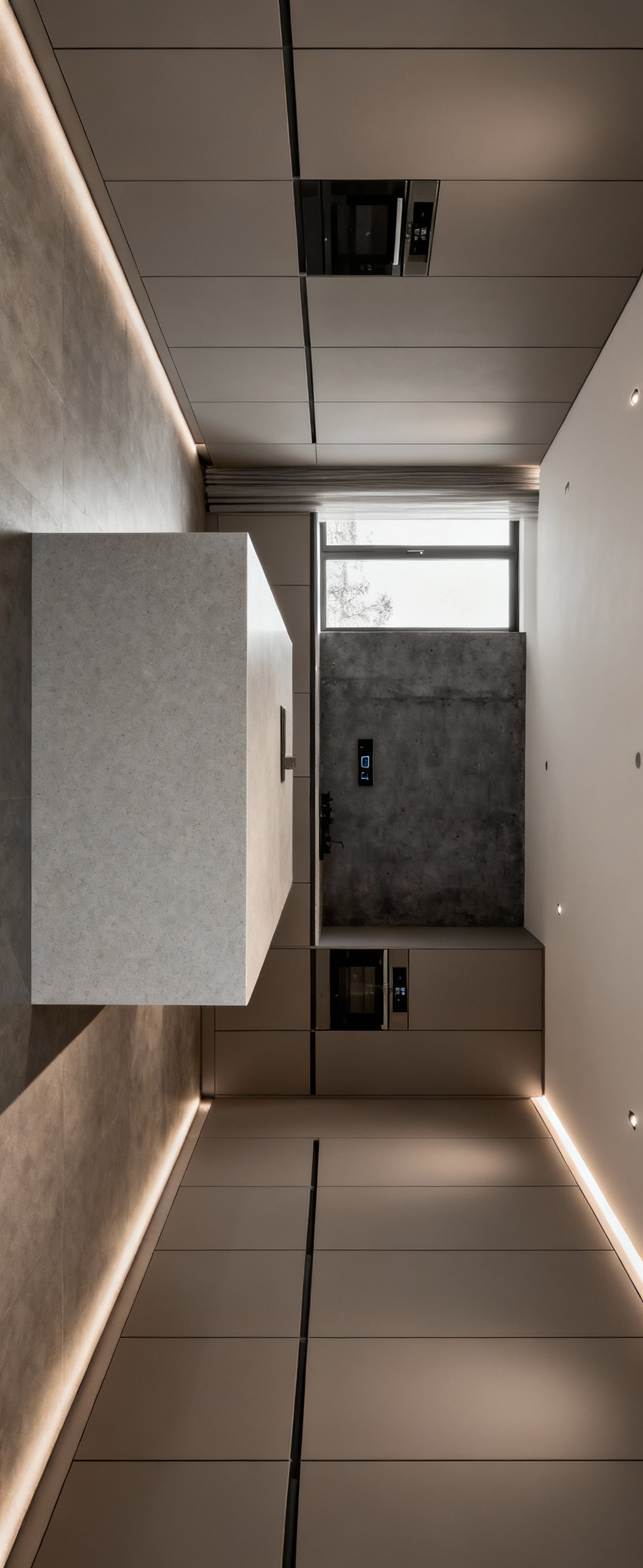
I always explain it to my readers as creating a “digital canvas.” Against this calm backdrop, a smart display showing a recipe, dynamic colored accent lighting for a party, or the rich texture of a stone island becomes a purposeful focal point, not just more visual noise. It gives your technology room to breathe and makes your deliberate design choices sing.
A single overhead fixture is a relic of the past. A truly modern kitchen uses three layers of light: ambient (overall illumination), task (focused light for chopping and cooking), and accent (to highlight architectural details). Getting this right completely changes the feel and function of a space, moving it from a sterile workshop to an inviting hub.
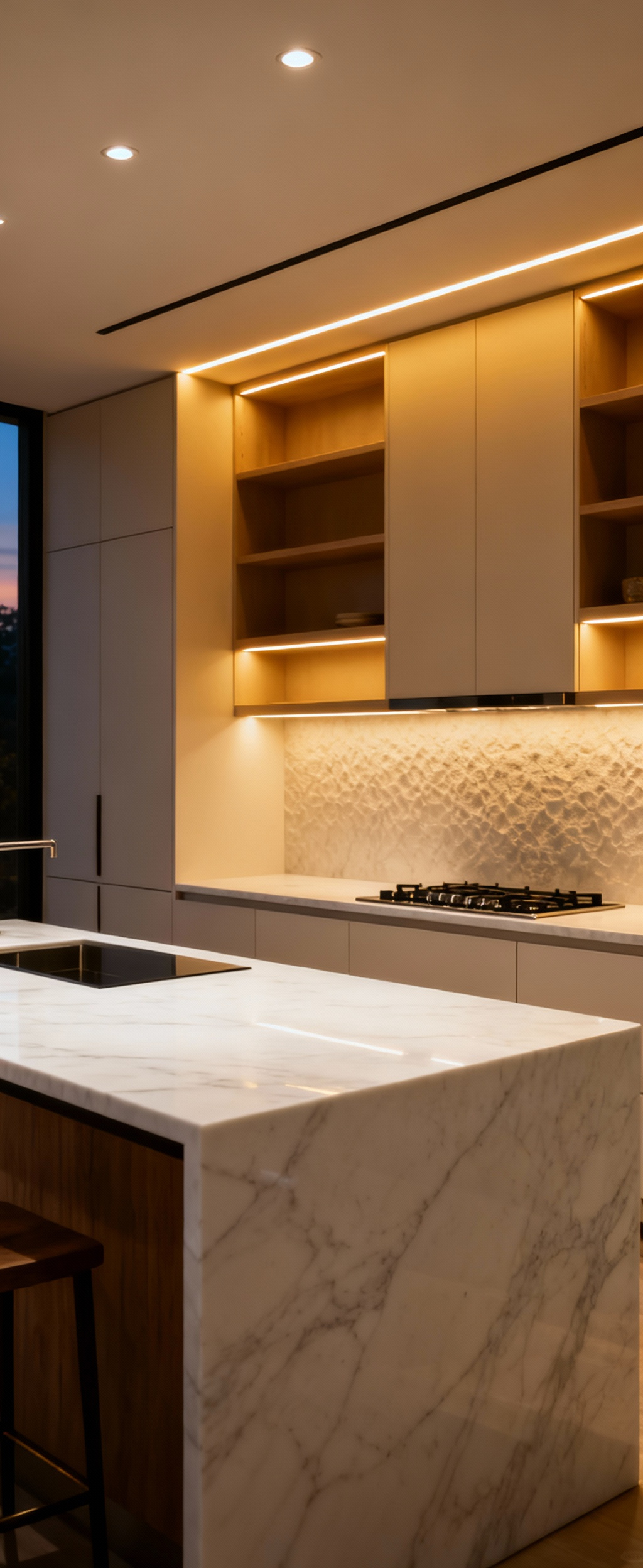
This is where the tech really gets fun. We don’t just layer light; we make it intelligent. From my work in home automation, the real magic is in tunable white lighting that can shift from a cool, energizing blue-white light for morning coffee to a warm, relaxing amber light for dinner. It can even sync with your circadian rhythm to support your natural energy cycles. That’s not just a smart kitchen; it’s a wellness-focused one.
Your countertops are the primary work surface, so they have to be bulletproof. Materials like engineered quartz, solid surface composites, or ultra-compact surfaces like sintered stone offer incredible durability, stain resistance, and a non-porous finish that’s incredibly hygienic. This low-maintenance aspect is the baseline for modern, efficient living.
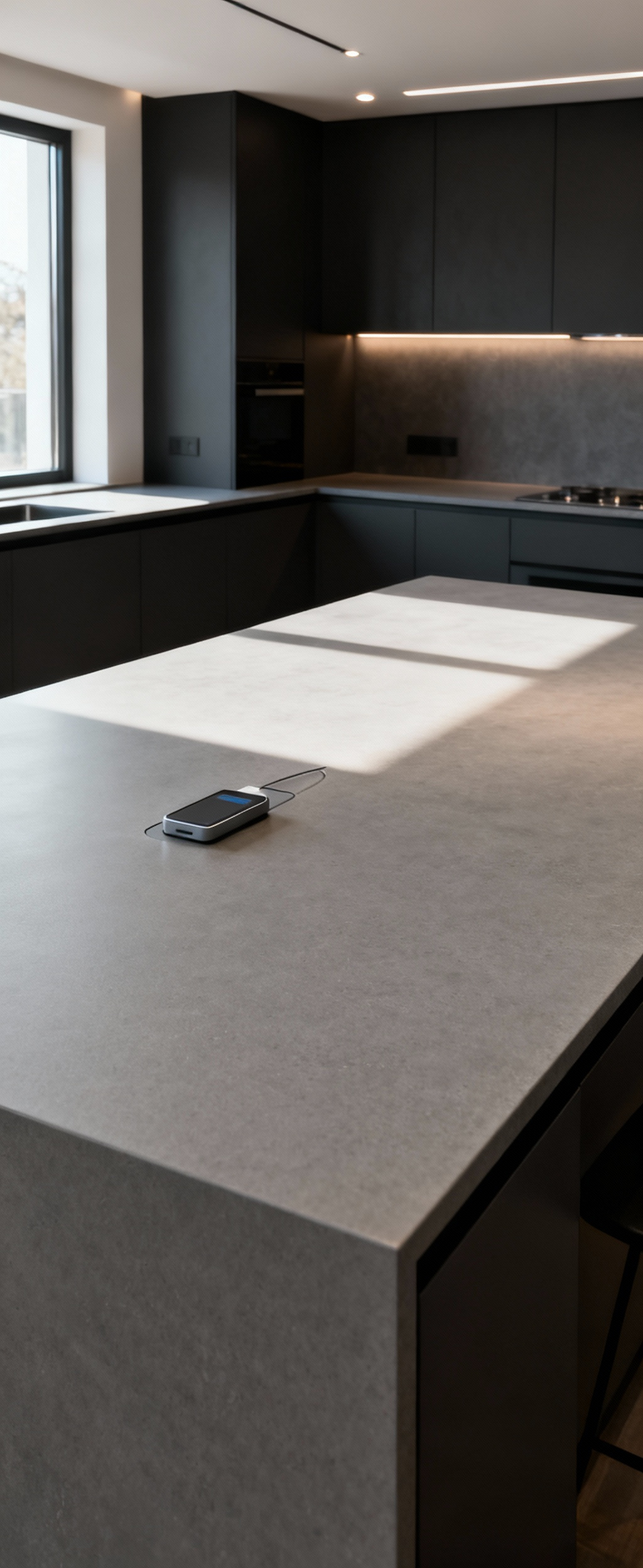
But we’re moving toward surfaces that do more. The next frontier is countertops with integrated technology. Think about built-in wireless charging pads that disappear when not in use, or even future-state induction burners that work directly through the countertop material, eliminating the need for a separate cooktop altogether. The counter is evolving from a passive slab to an active, intelligent surface.
With the fundamentals in place, it’s time to layer in the strategic elements that turn a beautiful kitchen into a high-performance one. This is about making smart choices that enhance flow, optimize every square inch, and integrate technology in a way that feels completely natural.
The kitchen island has evolved from a simple prep space into the undisputed command center of the modern kitchen. Of course, it should have seating and storage, but its real potential lies in its ability to consolidate function and technology. We’re talking integrated prep sinks, microwave drawers, and beverage fridges to create specialized work zones.
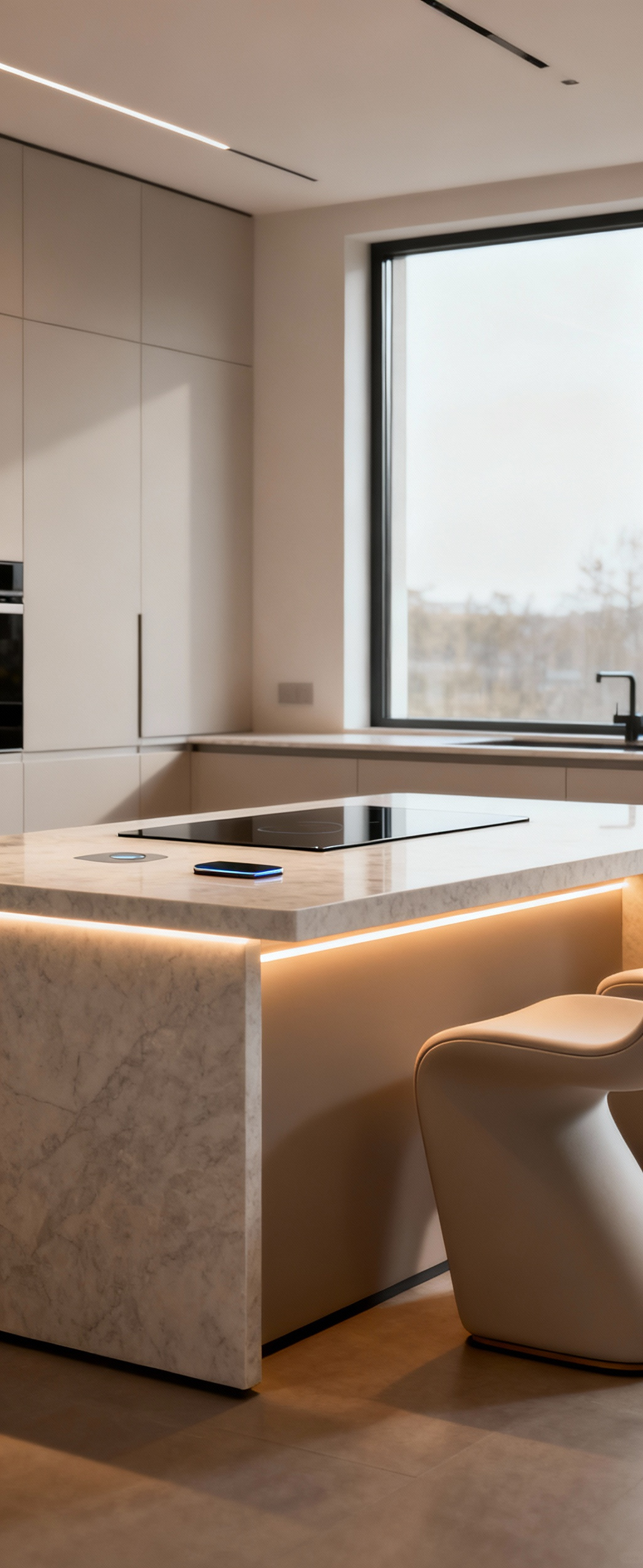
I always design islands with hidden infrastructure in mind: pop-up power outlets with USB-C ports, a discreet housing for a smart speaker, or even an integrated touchscreen to control the home’s lighting and audio. In my experience with tech-friendly design, concentrating this functionality in one central, elegant piece makes the entire kitchen run more smoothly.
A clean aesthetic is only possible with brilliant storage. The goal is a designated, easily accessible place for everything, keeping countertops free of clutter. Smart solutions like deep pull-out drawers, vertical dividers for trays, and clever corner systems are essential starting points that make every inch count.
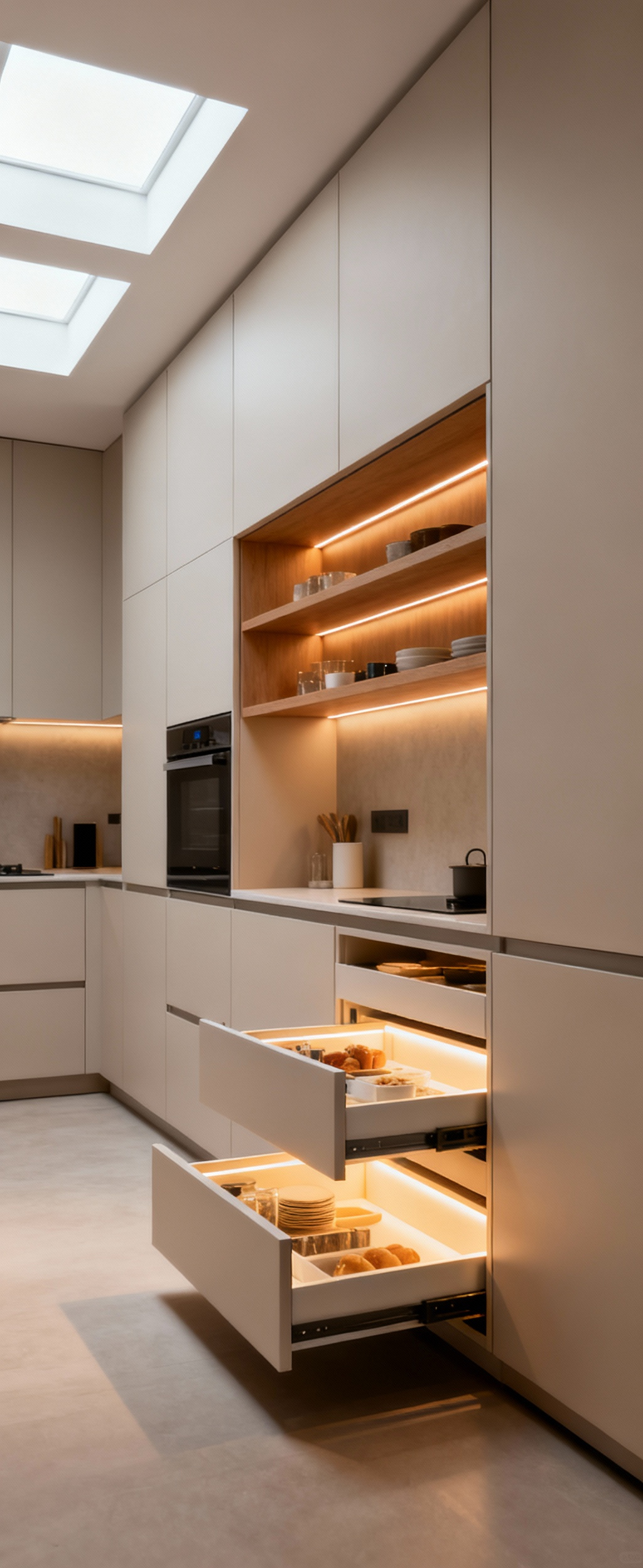
The tech integration here is a real game-changer. I’ve designed pantries with sensor-activated lighting that illuminates as you open the door and motorized shelves that bring hard-to-reach items down to you. The next step? Inventory systems that track what you use and automatically add it to your shopping list. This isn’t just about being organized; it’s about automating a tedious part of your life.
Modern appliances are about more than just cooking; they’re about precision, efficiency, and connectivity. I’m talking about steam-injection ovens for professional-level bread, induction cooktops with pinpoint temperature control, and refrigerators designed to keep produce fresh for weeks. Look for panel-ready models that can disappear into your cabinetry for the ultimate integrated look.

And the intelligence is key. The best systems don’t just connect to an app; they learn your habits. A truly smart appliance ecosystem will suggest recipes based on what’s in your fridge, preheat automatically based on your calendar, and send you a notification if a component needs maintenance before it breaks. It’s proactive, not just reactive.
The backsplash is no longer just a functional shield. It’s a prime opportunity to make a design statement. Extending a single slab of dramatic stone or minimalist porcelain from the counter to the ceiling creates a powerful, seamless focal point that defines the entire space. It’s a clean, grout-free solution that feels both luxurious and practical.

This is also an area ripe for innovation. I’ve been following the development of smart glass and interactive surfaces that could turn a backsplash into a display for recipes, news, or digital art. While still emerging for residential use, designing with a simple, monolithic backsplash today makes it much easier to upgrade to an interactive surface in the future.
Extending your cabinetry all the way to the ceiling is one of the most effective moves in modern kitchen design. It draws the eye upward, making the room feel taller and more spacious, while eliminating that awkward, dust-collecting gap. The top row of cabinets is perfect for storing items you don’t use every day.

What I tell my clients is that this is also a brilliant strategic move for hiding smart home tech. That upper real estate is the perfect place to discreetly conceal Wi-Fi routers, smart home hubs, or inline ventilation blowers, keeping the technology that powers your kitchen out of sight but easily accessible. It’s a perfect fusion of form and function.
Now we’re pushing the boundaries. These strategies are about creating a kitchen that not only looks and works beautifully today but is also designed to be healthy, sustainable, and adaptable for the technological changes of tomorrow.
Biophilic design is the practice of connecting our built environments with nature, and it’s a game-changer for how a kitchen feels. This can be as simple as designing for maximum natural light or creating a dedicated indoor herb garden. But it’s also about using natural materials like wood, stone, and metal to create textural interest and a sense of calm.

Tech can enhance this connection, not disrupt it. Think about smart, automated irrigation for that herb garden or a human-centric lighting system that mimics the natural color and intensity of daylight throughout the day. I’ve noticed this creates a space that’s not just efficient, but genuinely restorative.
A truly smart home anticipates your needs. Integrating your kitchen’s lighting and climate control into a unified system allows for effortless automation. This moves beyond a simple smart thermostat to a system of sensors and schedules that create the perfect environment without you ever touching a dial.

Imagine this: you walk into the kitchen in the morning, and the lights slowly fade up to a cool, energizing tone. In the evening, a “Cooking” scene sets bright task lighting over the island while the ventilation system kicks in automatically. Then, with a simple voice command, everything shifts to “Dinner Mode”—warm, dimmed lights, and soft music. This is technology that serves your lifestyle, seamlessly.
The old “kitchen triangle” is too simple for how we live now. Modern kitchen design relies on “zoning”—creating distinct workstations for different tasks. You might have a prep zone, a cooking zone, a baking station, and a coffee bar. Each zone has everything it needs, right where you need it.

Technology can supercharge these zones. For instance, a smart display in the prep zone can show your recipe, while task lighting automatically brightens when you’re there. This approach prevents household traffic jams and allows multiple people to use the kitchen at once without getting in each other’s way.
An ergonomic kitchen is designed around the human body to be comfortable, safe, and efficient. This goes beyond standard counter heights to include appliances placed at chest level to eliminate bending, faucets you can operate with a touch, and pull-out shelving that brings everything to you.

The future of ergonomics is adaptive technology. I learned this when designing for multi-generational homes: motorized countertops and cabinets that adjust their height for different users or tasks are revolutionary. It’s a core principle of universal design, ensuring your kitchen remains comfortable and accessible for anyone, at any stage of life.
A forward-thinking kitchen is an efficient one. This means specifying sustainable materials like recycled-content countertops and low-VOC finishes. But it also means choosing high-performance, energy-efficient appliances that reduce your environmental footprint and save you money in the long run.

In my professional experience, the smartest sustainability move is integrating your appliances with the smart grid. An intelligent dishwasher, washer, or EV charger can be programmed to run automatically during off-peak hours when electricity is cheapest and cleanest. That’s not just green—it’s brilliant.
This is the pinnacle—where the kitchen stops being a collection of smart objects and becomes a single, cohesive, and intelligent ecosystem that’s completely personalized to you.
Technology changes fast, but a good renovation should last for decades. So, how do you prepare for tech that doesn’t even exist yet? The answer is simple but critical: run conduit. Installing empty tubes inside your walls during construction is a small cost upfront that makes future upgrades (like running fiber optic cable or new power lines) incredibly easy.
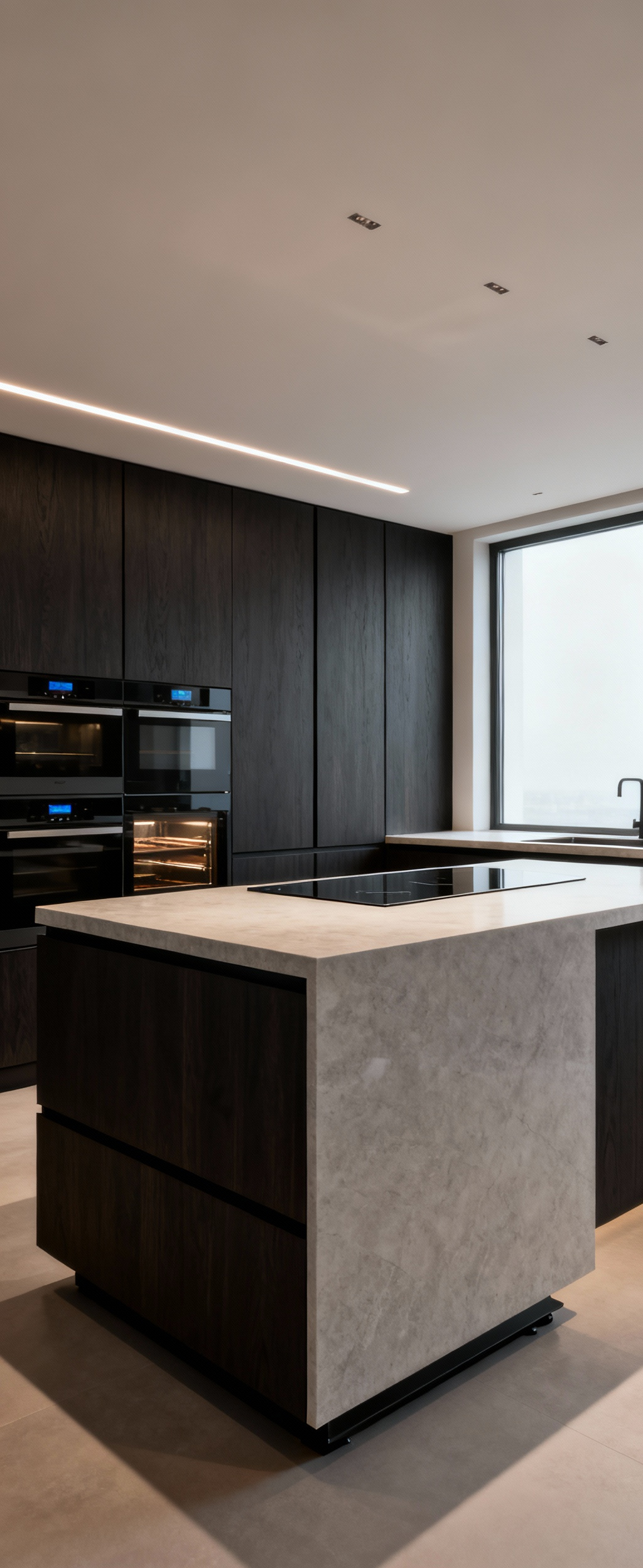
I stress this with every single client. It’s the “plumbing and electrical” for the next generation of technology. Alongside conduit, I always plan for a dedicated, ventilated closet for network gear. It keeps your home’s digital brain cool, quiet, and out of the way, ensuring your smart kitchen runs flawlessly.
True luxury is a space that’s perfectly tailored to your life. Hyper-personalization goes beyond choosing finishes. It’s about designing custom storage for your specific cookware, creating a dedicated baking station because you’re an avid baker, or integrating a professional-grade espresso machine if you’re a coffee connoisseur.

The next wave of this is an AI-driven environment. A kitchen that learns your routines and preferences—knowing you like the lights bright and the news on in the morning, or that you tend to cook more on weekends—and adjusts its settings automatically. It moves the kitchen from a tool you use to a partner that supports you.
The final step is breaking down the walls between the kitchen and the rest of your home. A masterful smart home integration means the kitchen works in concert with your security, climate, and entertainment systems. It’s not just about what happens inside the kitchen; it’s about how the kitchen responds to your life.

For example, your security system disarms and signals the house to enter “Home” mode, which triggers the kitchen lights to fade on to a welcoming scene. Or your car’s GPS tells your oven to start preheating when you’re ten minutes away. This is where technology disappears into the background and simply makes your life better, more efficient, and more enjoyable. It’s the ultimate goal of any future-focused kitchen design modern project.
So there you have it. We’ve moved from simple design choices to a fully integrated, intelligent system. The biggest takeaway should be this: a truly modern kitchen is not a showroom of gadgets. It’s a thoughtful ecosystem where design and technology work together to create a space that is efficient, beautiful, and deeply personal. It’s a long-term investment in a smarter, more seamless way of living.
Think of these concepts as a blueprint. The goal is to create a kitchen that feels less like a collection of appliances and more like an intuitive partner in your daily life. The future isn’t about having more tech; it’s about having technology so perfectly integrated that it simply disappears, leaving you with an effortless, inspiring space. Now go build it.
Meta Description: Transform your space with these 20 modern kitchen design ideas. Expert James Hartford shares how to integrate smart tech for a beautiful, future-ready home.